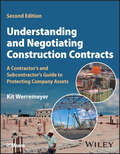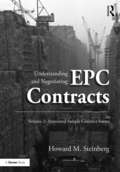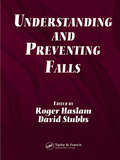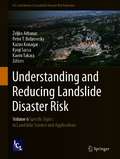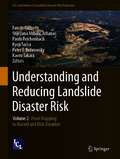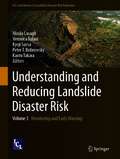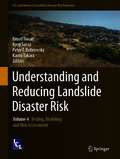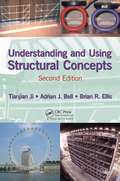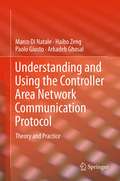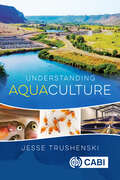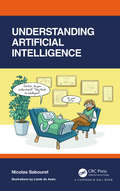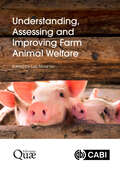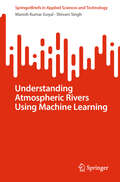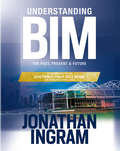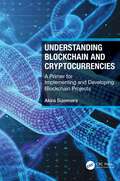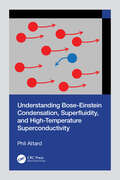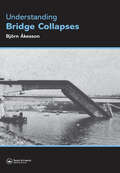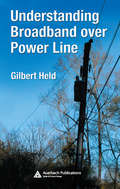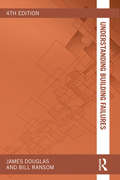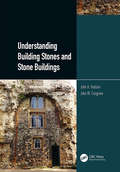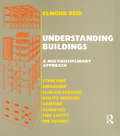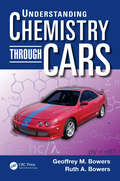- Table View
- List View
Understanding and Negotiating Construction Contracts: A Contractor's and Subcontractor's Guide to Protecting Company Assets
by Kit WerremeyerUnderstanding and Negotiating Construction Contracts The complexities of construction contracts are made easy with this thorough and readable guide Construction contracts can be complex for both owners and contractors. For contractors, negotiating fair and balanced commercial terms in contracts is just as important as properly managing projects; a properly negotiated contract can mitigate unnecessary risk and unnecessary risk transfer. This, in turn, reduces exposure to financial liability for the contractor and for avoidance of contract claims and disputes. Understanding and Negotiating Construction Contracts provides a comprehensive and readable introduction to the world of construction contracts. Providing, for example, coverage of the four most common types of contracts—lump sum/fixed-price, cost-plus, time-and-materials, and unit-pricing—it promises to reduce uncertainty and allow contractors to enter contractual negotiations with greater confidence to be able to achieve a fair and balanced contract. This updated new edition reflects the up-to-date best practices to understand how to better negotiate the commercial terms and conditions in construction contracts. Readers of the second edition of Understanding and Negotiating Construction Contracts will also find: Updated information on indemnity, insurance, and negotiation An all-new chapter with a contract analysis checklist Real-world examples drawn from small residential, retail, large commercial, and international projects Understanding and Negotiating Construction Contracts is essential for construction professionals and college students studying construction contracts and the liabilities arising out of them.
Understanding and Negotiating EPC Contracts, Volume 2: Annotated Sample Contract Forms
by Howard M. SteinbergAny project which involves an EPC contract is also likely to involve a number of other complicated contracts. The challenge of the parties to an EPC contract is not to try to eliminate risk but rather put into place a narrative structure that enables the parties to predict the contractual result that would obtain if a risk materializes. If the EPC contract does not allow the parties to determine the consequences of an unanticipated situation, they will have to look to an expert, mediator, tribunal, or court to impart guidance or pass judgment. The sample forms of contract contained in Volume 2 of Understanding and Negotiating EPC Contracts are intended to serve as a guide to demonstrate how risks and responsibilities can be allocated among project sponsors, EPC contractors and the various other parties that may be involved in a project. Collectively the sample forms in this volume offer an extraordinary resource that provides the benefit of lessons learned and priceless insight into any project being undertaken which can help assure the resilience of any EPC project.
Understanding and Preventing Falls: An Ergonomics Approach
by Roger Haslam David StubbsReadable and authoritative, Understanding and Preventing Falls provides a guide to the nature and extent of the problem of falls. Drawing on the latest research, the authors outline the combination of environmental factors that commonly lead to falls and explore how to prevent them. The case is made for a multifaceted approach to falls prevention,
Understanding and Reducing Landslide Disaster Risk: Volume 6 Specific Topics in Landslide Science and Applications (ICL Contribution to Landslide Disaster Risk Reduction)
by Peter T. Bobrowsky Kyoji Sassa Željko Arbanas Kaoru Takara Kazuo KonagaiThis book is a part of ICL new book series “ICL Contribution to Landslide Disaster Risk Reduction” founded in 2019. Peer-reviewed papers submitted to the Fifth World Landslide Forum were published in six volumes of this book series. This book contains the following parts:• Impact of Large Ground Deformations near Seismic Faults on Critically Important Civil Infrastructures• Recent Progress in the Landslide Initiating Science• Earth Observation and Machine Learning in Landslide Science• General Landslide StudiesProfessor Željko Arbanas is the Vice President of International Consortium on Landslides. He is a Professor of Faculty of Civil Engineering, University of Rijeka, Croatia. He is the Assistant Editor-in-Chief of International Journal Landslides.Professor Peter Bobrowsky is the President of International Consortium on Landslides. He is a Senior Scientist of Geological Survey of Canada, Ottawa, Canada.Professor Kazuo Konagai is Professor Emeritus at the University of Tokyo and Principal Researcher at the ICL Headquarters. He serves as the Secretary-General of the Fifth World Landslide Forum.Professor Kyoji Sassa is the Founding President and the Secretary-General of the International Consortium on Landslides (ICL). He has been the Editor-in-Chief of International Journal Landslides since its foundation in 2004.Professor Kaoru Takara is the Executive Director of International Consortium on Landslides. He is a Professor and Dean of Graduate School of Advanced Integrated Studies (GSAIS) in Human Survivability (Shishu-Kan), Kyoto University.
Understanding and Reducing Landslide Disaster Risk: Volume 2 From Mapping to Hazard and Risk Zonation (ICL Contribution to Landslide Disaster Risk Reduction)
by Peter T. Bobrowsky Kyoji Sassa Fausto Guzzetti Kaoru Takara Snježana Mihalić Arbanas Paola ReichenbachThis book is a part of ICL new book series “ICL Contribution to Landslide Disaster Risk Reduction” founded in 2019. Peer-reviewed papers submitted to the Fifth World Landslide Forum were published in six volumes of this book series. This book contains the followings:• Keynotes• Landslide detection, recognition and mapping• Landslide susceptibility assessment and modelling• Landslide size statistics and temporal modelling• Data and information for landslide disaster mitigation• Vulnerability to landslides of people, communities and the built environmentDr. Fausto Guzzetti is General Director of Office III – Technical and Scientific Activities for Risk Forecasting and Prevention, Department of Civil Protection, Italian Presidency of the Council of Ministers, on leave from the Italian National Research Council.Prof. Snježana Mihalić Arbanas is a Full Professor of the Faculty of Mining, Geology and Petroleum Engineering of the University of Zagreb, Croatia. She is the Chair of ICL Network Committee.Paola Reichenbach is a Senior Researcher of the Research Institute for Geo-Hydrological Protection, an institute of the Italian National Research Council (IRPI-CNR), Perugia, Italy.Prof. Kyoji Sassa is the Founding President and the Secretary-General of the International Consortium on Landslides (ICL). He has been the Editor-in-Chief of International Journal Landslides since its foundation in 2004.Prof. Peter Bobrowsky is the President of the International Consortium on Landslides. He is a Senior Scientist of Geological Survey of Canada, Ottawa, Canada.Prof. Kaoru Takara is the Executive Director of the International Consortium on Landslides. He is a Professor and Dean of Graduate School of Advanced Integrated Studies (GSAIS) in Human Survivability (Shishu-Kan), Kyoto University.
Understanding and Reducing Landslide Disaster Risk: Volume 3 Monitoring and Early Warning (ICL Contribution to Landslide Disaster Risk Reduction)
by Nicola Casagli Veronica Tofani Kyoji Sassa Peter T. Bobrowsky Kaoru TakaraThis book is a part of ICL new book series “ICL Contribution to Landslide Disaster Risk Reduction” founded in 2019. Peer-reviewed papers submitted to the Fifth World Landslide Forum were published in six volumes of this book series. This book contains the followings:• One theme lecture and one keynote lecture• Monitoring and remote sensing for landslide risk mitigation, including one keynote lecture• Landslide early warning systems, forecasting models and time prediction of landslidesProf. Nicola Casagli is a Vice President and President-elect of the International Consortium on Landslides (ICL) for 2021–2023. He is Professor of engineering geology at the Department of Earth Sciences, University of Florence, and President of the National Institute of Oceanography and Applied Geophysics – OGS, Trieste, Italy.Dr. Veronica Tofani is an Associate Professor at the Department of Earth Sciences, University of Florence, and Program Coordinator of the UNESCO Chair on Prevention and Sustainable Management of Geo-hydrological hazards, University of Florence.Prof. Kyoji Sassa is the Founding President and the Secretary-General of the International Consortium on Landslides (ICL). He has been the Editor-in-Chief of International Journal Landslides since its foundation in 2004.Prof. Peter Bobrowsky is the President of the International Consortium on Landslides. He is a Senior Scientist of Geological Survey of Canada, Ottawa, Canada.Prof. Kaoru Takara is the Executive Director of the International Consortium on Landslides. He is a Professor and Dean of Graduate School of Advanced Integrated Studies (GSAIS) in Human Survivability (Shishu-Kan), Kyoto University.
Understanding and Reducing Landslide Disaster Risk: Volume 1 Sendai Landslide Partnerships and Kyoto Landslide Commitment (ICL Contribution to Landslide Disaster Risk Reduction)
by Kyoji Sassa Matjaž Mikoš Shinji Sassa Peter T. Bobrowsky Kaoru Takara Khang DangThis book is a part of ICL new book series “ICL Contribution to Landslide Disaster Risk Reduction” founded in 2019. Peer-reviewed papers submitted to the Fifth World Landslide Forum were published in six volumes of this book series. This book contains the followings:• Four Forum lectures and one award paper• Sendai Landslide Partnerships, Kyoto Landslide Commitment, and International Programme on Landslides.• Landslide-induced tsunamis• Landslides at UNESCO designates sites and contribution from WMO, FAO, and IRDR• Education and Capacity Development for Risk Management and Risk GovernanceProf. Kyoji Sassa is the Founding President and the Secretary-General of International Consortium on Landslides (ICL). He has been the Editor-in-Chief of International Journal Landslides since its foundation in 2004.Prof. Matjaž Mikoš is the Vice President of International Consortium on Landslides and Vice President of Slovenian Academy of Engineering. He is a Professor and Dean of Faculty of Civil and Geodetic Engineering, University of Ljubljana, Slovenia.Dr. Shinji Sassa is Head of Soil Dynamics Group and Research Director of International Research Center for Coastal Disasters, Port and Airport Research Institute, National Institute of Maritime, Port and Aviation Technology, Japan.Prof. Peter Bobrowsky is the President of International Consortium on Landslides. He is a Senior Scientist of Geological Survey of Canada, Ottawa, Canada.Prof. Kaoru Takara is the Executive Director of International Consortium on Landslides. He is a Professor and Dean of Graduate School of Advanced Integrated Studies (GSAIS) in Human Survivability (Shishu-Kan), Kyoto University.Dr. Khang Dang is the Secretary General of the Fifth World Landslide Forum. He also serves as the Research Promotion Officer of ICL and a Lecturer at the University of Science, Vietnam National University, Hanoi.
Understanding and Reducing Landslide Disaster Risk: Volume 4 Testing, Modeling and Risk Assessment (ICL Contribution to Landslide Disaster Risk Reduction)
by Binod Tiwari Kyoji Sassa Peter T. Bobrowsky Kaoru TakaraThis book is a part of ICL new book series “ICL Contribution to Landslide Disaster Risk Reduction” founded in 2019. Peer-reviewed papers submitted to the Fifth World Landslide Forum were published in six volumes of this book series. This book contains the followings:• Five keynote lectures• Recent development in physical modeling of landslides• Recent development in numerical modeling of landslides• Recent development in soil and rock testing techniques, application and analysis methods• Recent advancements in the methods of slope stability and deformation analyses• Recent development in disaster risk assessmentProf. Binod Tiwari is a Vice President of the International Consortium on Landslides (ICL). He is the Associate Vice President for research and sponsored project and Professor of civil and environmental engineering at the California State University, Fullerton, California, USA.Prof. Kyoji Sassa is the Founding President and the Secretary-General of the International Consortium on Landslides (ICL). He has been the Editor-in-Chief of International Journal Landslides since its foundation in 2004.Prof. Peter Bobrowsky is the President of the International Consortium on Landslides. He is a Senior Scientist of Geological Survey of Canada, Ottawa, Canada.Prof. Kaoru Takara is the Executive Director of the International Consortium on Landslides. He is a Professor and Dean of Graduate School of Advanced Integrated Studies (GSAIS) in Human Survivability (Shishu-Kan), Kyoto University.
Understanding and Reducing Landslide Disaster Risk: Volume 5 Catastrophic Landslides and Frontiers of Landslide Science (ICL Contribution to Landslide Disaster Risk Reduction)
by Vít Vilímek Fawu Wang Alexander Strom Kyoji Sassa Peter T. Bobrowsky Kaoru TakaraThis book is a part of ICL new book series “ICL Contribution to Landslide Disaster Risk Reduction” founded in 2019. Peer-reviewed papers submitted to the Fifth World Landslide Forum were published in six volumes of this book series. This book contains the followings:Part I with topics is mainly about landslides and earthquakes; landslide dams and outburst floods; catastrophic large-scale landslides in mountainous regions.Part II with topics is mainly about impact of climate change; loess landslides; mapping, monitoring and modeling of landslides; stabilization and mitigation; application of new technology in landslide studies.Prof. Vít Vilímek is the vice-president of the International Consortium on Landslides (ICL) and a member of the evaluation committee, Editor-in-Chief of the university journal AUC Geographica and Associate Editor-in-Chief of the international journal Geoenvironmental Disasters. He is a Professor of Physical Geography at Charles University, Prague, Czech Republic.Prof. Fawu Wang is the President of the International Consortium on Geo-disaster Reduction (ICGdR) and the Editor-in-Chief of the international journal Geoenvironmental Disasters. He is a Professor at the School of Civil Engineering, Tongji University, China.Dr. Alexander Strom is a chief expert at the Geodynamics Research Center LLC, Moscow, Russia. He is also an Adjunct Professor at Chang’an University, Xi’an, China, Visiting Professor at SKLGP, Chengdu, China, and an alternative representative of the JSC “Hydroproject Institute” in ICL.Prof. Kyoji Sassa is the Founding President and the Secretary-General of the International Consortium on Landslides (ICL). He has been the Editor-in-Chief of International Journal Landslides since its foundation in 2004.Prof. Peter Bobrowsky is the President of the International Consortium on Landslides. He is a Senior Scientist of Geological Survey of Canada, Ottawa, Canada.Prof. Kaoru Takara is the Executive Director of the International Consortium on Landslides. He is a Professor and Dean of Graduate School of Advanced Integrated Studies (GSAIS) in Human Survivability (Shishu-Kan), Kyoto University.
Understanding and Using Structural Concepts
by Tianjian Ji Adrian J. Bell Brian R. EllisUnderstanding and Using Structural Concepts, Second Edition provides numerous demonstrations using physical models and practical examples. A significant amount of material, not found in current textbooks, is included to enhance the understanding of structural concepts and stimulate interest in learning, creative thinking, and design. This is achiev
Understanding and Using the Controller Area Network Communication Protocol
by Paolo Giusto Arkadeb Ghosal Haibo Zeng Marco Di NataleThis book to offers a hands-on guide to designing, analyzing and debugging a communication infrastructure based on the Controller Area Network (CAN) bus. Although the CAN bus standard is well established and currently used in most automotive systems, as well as avionics, medical systems and other devices, its features are not fully understood by most developers, who tend to misuse the network. This results in lost opportunities for better efficiency and performance. These authors offer a comprehensive range of architectural solutions and domains of analysis. It also provides formal models and analytical results, with thorough discussion of their applicability, so that it serves as an invaluable reference for researchers and students, as well as practicing engineers.
Understanding Aquaculture
by Jesse TrushenskiRoughly half the seafood we eat comes from farms, and yet many consumers remain hesitant, even resistant, to buying farmed fish. Aquaculture is compared with both terrestrial agriculture and capture fisheries and has endured considerable, often unfounded, criticism. Understanding Aquaculture addresses the controversial aspects of aquaculture, answering common questions about the industry and farmed seafood. Are farmed fish safe to eat? Are wild fish more nutritious? Do fish farms pollute the environment? Understanding Aquaculture sets the record straight for the world's most important source of seafood. Aquaculture is critical to food security, both now and in the future, and an informed and supportive public is needed to ensure its potential is fully realized. Informative and engaging, Understanding Aquaculture is a thoroughly researched resource for students and practitioners, but manages to put the facts within reach of casual readers.
Understanding Artificial Intelligence
by Nicolas SabouretArtificial Intelligence (AI) fascinates, challenges and disturbs us. There are many voices in society that predict drastic changes that may come as a consequence of AI – a possible apocalypse or Eden on earth. However, only a few people truly understand what AI is, what it can do and what its limitations are. Understanding Artificial Intelligence explains, through a straightforward narrative and amusing illustrations, how AI works. It is written for a non-specialist reader, adult or adolescent, who is interested in AI but is missing the key to understanding how it works. The author demystifies the creation of the so-called "intelligent" machine and explains the different methods that are used in AI. It presents new possibilities offered by algorithms and the difficulties that researchers, engineers and users face when building and using such algorithms. Each chapter allows the reader to discover a new aspect of AI and to become fully aware of the possibilities offered by this rich field.
Understanding, Assessing and Improving Farm Animal Welfare
by Luc MounierImproving welfare in farmed animals is good for productivity, consumer demand and, of course, the animals themselves. Covering the current scientific knowledge on the sensitivity and consciousness of animals, this translation of the Le Bien-être des animaux d'élevage series reviews how to understand, assess and then improve farm animal welfare. Beginning with the philosophical and legal history of the consideration of their well-being, it synthesizes this information to build a common reference so that we all share the same notion of what animal welfare actually is. It then evaluates the welfare assessment process, which must be as reliable and objective as possible and require the use of appropriate indicators. Fully outlined in reference documents, these are summarized at the level of specific farming situations for easy reference. Concluding with the different ways of improving animal welfare, the book takes a holistic approach, considering the animals' physical and social environment, the integrated management of their health, the relationship between human and animal, the management of animal suffering, and treatment of animals during transportation and slaughter. Suitable for students and researchers of animal agriculture, animal science and veterinary medicine, this book provides an approachable and comprehensive coverage of this important topic.
Understanding Atmospheric Rivers Using Machine Learning (SpringerBriefs in Applied Sciences and Technology)
by Manish Kumar Goyal Shivam SinghThis book delves into the characterization, impacts, drivers, and predictability of atmospheric rivers (AR). It begins with the historical background and mechanisms governing AR formation, giving insights into the global and regional perspectives of ARs, observing their varying manifestations across different geographical contexts. The book explores the key characteristics of ARs, from their frequency and duration to intensity, unraveling the intricate relationship between atmospheric rivers and precipitation. The book also focus on the intersection of ARs with large-scale climate oscillations, such as El Niño and La Niña events, the North Atlantic Oscillation (NAO), and the Pacific Decadal Oscillation (PDO). The chapters help understand how these climate phenomena influence AR behavior, offering a nuanced perspective on climate modeling and prediction. The book also covers artificial intelligence (AI) applications, from pattern recognition to prediction modeling and early warning systems. A case study on AR prediction using deep learning models exemplifies the practical applications of AI in this domain. The book culminates by underscoring the interdisciplinary nature of AR research and the synergy between atmospheric science, climatology, and artificial intelligence
Understanding Australian Construction Contractors: A Guide for Emerging Professionals
by Matt Stevens John SmoldersThis book will provide emerging construction professionals with insights and information helpful for a successful career in the Australian construction industry. This work fills a critical gap and is written by two authors with decades of experience immersed in current issues. It provides a starting point for the next generation of Australian construction contractors. Beginning with an overview of the industry, the chapters explore winning work, project operations, financial management, people skills and selling a successful business. The authors use case studies to enrich the content and include reviews and commentaries on some of the legendary management books. In addition, readers of the book will find answers to essential industry questions: Why is construction one of the best industries in Australia? What is its most significant conflict? Which are the three most consistently profitable sectors? What are the essential ten questions to answer for standardising practices? Is work acquisition more art or science? Is it a good idea to fire a client? Why? How to identify and address the office - field conflict? What is the job cost format for unifying project stakeholder information? What are the best key performance indicators for a construction contracting firm? What alignments are needed in general hiring and personnel management processes? What is the process in identifying and implementing a best practice? How do you value the market price for a construction firm? This book should be read by anyone entering the built environment sector in Australia. Universities, Colleges and TAFEs can use this book in various construction business and operations management courses. Supporting materials are available through a website.
Understanding BIM: The Past, Present and Future
by Jonathan IngramUnderstanding BIM presents the story of Building Information Modelling, an ever evolving and disruptive technology that has transformed the methodologies of the global construction industry. Written by the 2016 Prince Philip Gold Medal winner, Jonathan Ingram, it provides an in-depth understanding of BIM technologies, the business and organizational issues associated with its implementation, and the profound advantages its effective use can provide to a project team. Ingram, who pioneered the system heralding the BIM revolution, provides unrivalled access to case material and relevance to the current generation of BIM masters. With hundreds of colour images and illustrations showing the breadth and power of BIM, the book covers: The history of BIM What BIM is in technical and practical terms How it changes the day to day working environment Why we need BIM and what problems it can solve Where BIM is headed, particularly with regards to AI, AR, VR and voice recognition International case studies from a range of disciplines including: architecture, construction management, and retail Professionals and students in any field where the inter-disciplinary aspects of BIM are in operation will benefit from Ingram’s insights. This book is an authoritative account of and reference on BIM for anyone wanting to understand its history, theory, application and potential future developments.
Understanding Blockchain and Cryptocurrencies: A Primer for Implementing and Developing Blockchain Projects
by Akira SummersWhether you are a project manager looking to lead blockchain projects, a developer who would like to create blockchain-based applications, or a student with an interest, this book will provide you with the foundational understanding that you need.You have probably noticed that blockchains are growing in popularity. Governments are investigating Digital Currencies, supply chains are adopting Digital Ledgers, games makers and artists are developing NFTs (Non-Fungible Tokens), and new use-cases are emerging regularly.With such growth, many people will find themselves needing to understand how these technologies work. There will be new project teams, with technical leads managing blockchain projects and developers creating distributed applications. This book is great for them as it explains the concepts on which blockchain technologies are based, in simple terms.We will discuss and explain topics such as hashing, Merkle trees, nodes, mining, proof of work and proof of stake, consensus mechanisms encryption, vulnerabilities, and much more. The structures and principles described will be relevant for developers and managers alike, and will be demonstrated through relevant examples throughout the text.If you are looking to understand this exciting new technology, this is the book for you.
Understanding Bose-Einstein Condensation, Superfluidity, and High-Temperature Superconductivity
by Phil AttardBose-Einstein condensation, superfluidity, and superconductivity are quantum mechanics made visible. They mark the boundary between the classical and the quantum worlds, and they show the macroscopic role of quantum mechanics in condensed matter.This book presents these phenomena in terms of particles, their positions, and their momenta, giving a concrete visualisation and description that is not possible with traditional wave functions. A single approach that bridges the classical-quantum divide provides new insight into the role of particle interactions in condensation, the nature of collisions in superfluid flow, and the physical form of Cooper pairs in high-temperature superconductors.High-temperature superconductivity is explored with quantum statistical mechanics, which links it to Bose-Einstein condensation. Identifying a new mechanism for Cooper pairing, this explains the differences between the low- and high-temperature superconducting regimes and the role of the molecular structure of the conductor.The new perspective offered by this book on Bose-Einstein condensation, superfluidity, and high-temperature superconductivity gives particle-based explanations as well as mathematical and computational methods for these macroscopic quantum phenomena so that readers understand the role of particle interactions and structure in the physics of these phenomena.This book will appeal to undergraduate and graduate students, lecturers, academics, and scientific researchers in the fields of Bose-Einstein condensation and condensates, superfluidity, and superconductivity. It will also be of interest to those working with thermodynamics, statistical mechanics, statistical physics, quantum mechanics, molecular dynamics, materials science, condensed matter physics, and theoretical chemistry.Key Features:· Explores Bose-Einstein condensation with new evidence for multiple condensed states and novel Monte Carlo simulations for interacting bosons· Establishes the thermodynamic nature of condensed bosons from an analysis of fountain pressure measurements, including that they carry energy and entropy, and the thermodynamic principle of superfluid flow· Derives equations of motion for condensed bosons, and performs molecular dynamics simulations of the viscosity with molecular trajectories that give rise to superfluidity· Identifies the mechanism for electron pairing in high-temperature superconductivity
Understanding Bridge Collapses
by Björn ÅessonThis book presents a detailed overview of 20 cases of famous and other highly interesting bridge collapses over the last two centuries. Every case is illustrated and described in detail and the failure analyses made are supported by well-known explanations and, in some cases, by new theories. The chronological order makes it easy to follow the gradual development in the use of different bridge types and the choice of construction material. This analysis of the complex phenomena of fatigue and buckling is a critical area for consulting engineers and for advanced-level and postgraduate students in structural and bridge engineering.
Understanding Broadband over Power Line
by Gilbert HeldUnderstanding Broadband over Power Line explores all aspects of the emerging technology that enables electric utilities to provide support for high-speed data communications via their power infrastructure. This book examines the two methods used to connect consumers and businesses to the Internet through the utility infrastructure: the existing ele
Understanding Building Failures (Understanding Construction)
by Bill Ransom James DouglasBuilding defects still continue to plague the construction industry. The lessons learned over the last forty years have not been fully applied. Many new or refurbished buildings still leak or crack. Lack of awareness by designers and installers as to the main mechanisms that trigger such failures remains a problem for the industry. Investigating and rectifying building failures form a major part of building surveyors’ bread and butter work. This book provides guidance on this work for typical residential, commercial and industrial buildings – with advice on how to diagnose a wide range of defects with an emphasis on evidence based practice throughout. It considers both modern and older construction methods, together with new and traditional materials. The particular problems of alteration and renovation work are also discussed. The first four chapters provide information and guidance on the methodology for investigating failures – how to prepare for and conduct an investigation into a building defect and subsequently diagnose its cause in a logical manner. This fourth edition has been updated and expanded to cover the latest diagnostic procedures and research. It also includes Appendices and a new Bibliography, and provides an extensive list of books on building pathology and related topics in the UK and North America. It is essential reading for all students and practitioners interested in building surveying and building conservation.
Understanding Building Stones and Stone Buildings
by John A. Hudson John W. CosgroveThis book covers the wide spectrum of subjects relating to obtaining and using building stones, starting with their geological origin and then describing the nature of granites, volcanics, limestones, sandstones, flint, metamorphic stones, breccias and conglomerates, with emphasis being placed on how to recognise the different stones via the many illustrated examples from Great Britain and other countries. The life of a building stone is explained from its origin in the quarry, through its exposure to the elements when used for a building, to its eventual deterioration. The structure of stone buildings is then discussed, with explanations of the mechanics of pillars, lighthouses and walls, arches, bridges, buttresses and roof vaults, plus castles and cathedrals. The sequence of the historical architectural styles of stone buildings is explained—from the early days through to postmodern buildings. Special attention is paid to two famous architects: the Roman Vitruvius and the English Sir Christopher Wren who designed and supervised the construction of St. Paul’s Cathedral in London. To demonstrate many of the concepts presented, two exemplary stone buildings are described in detail: the Albert Memorial in London and Durham Cathedral in northern England. The former building is interesting because it is comprised of a cornucopia of different building stones and the latter building because of its architecture and sandstone decay mechanisms. In the final Chapter, ruined stone buildings are discussed—the many reasons for their decay and the possibility of their ‘rebirth’ via digital recording of their geometry. The book has over 350 pages and is illustrated with more than 450 diagrams and colour photographs of both the various stones and the associated stone buildings. Readers’ knowledge of the subject will be greatly enhanced by these images and the related explanatory text. A wide-ranging references and bibliography section is also included.
Understanding Buildings a Multidisciplinary Approach: A Multidisciplinary Approach
by E. ReidThis book meets the needs for a basic, yet comprehensive and up-to-date, introductory text to building technology for students in architecture and the other disciplines in building design. The wide coverage is organised under the chapter headings: structure, enclosure, climate services, utility services, lighting, acoustics, fire safety, the future? The treatment in each case is concentrated on the close relationship between good design practice and the basic underlying scientific and practical principles, but stopping short of the high level theory which is to be found in other more closely specialised texts.This well illustrated and highly readable book will be invaluable to the student and of interest to the practitioner too, both in architecture and in its related technical fields.
Understanding Chemistry through Cars
by Geoffrey M. Bowers Ruth A. BowersAs the car anticipates its dance around the racetrack, the engine growls and pops, and all senses become immersed in the smell of exhaust vapors and the sounds of raw speed and excitement. As it turns out, these also are the sights, sounds, and smells of chemistry! The car is a great example of an everyday device with an abundance of chemistry hidi
